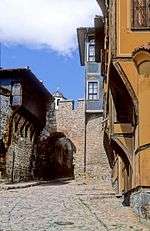Bulgarian National Revival
Part of a series on the |
|---|
| History of Bulgaria |
.svg.png) |
|
|
Main category |
The Bulgarian National Revival (Bulgarian: Българско национално възраждане, Balgarsko natsionalno vazrazhdane or simply: Възраждане, Vazrazhdane), sometimes called the Bulgarian Renaissance, was a period of socio-economic development and national integration among Bulgarian people under Ottoman rule. It is commonly accepted to have started with the historical book, Istoriya Slavyanobolgarskaya,[1] written in 1762 by Paisius, a Bulgarian monk of the Hilandar monastery at Mount Athos, and lasted until the Liberation of Bulgaria in 1878 as a result of the Russo-Turkish War of 1877-78.
Characteristics
The period is remarkable for its characteristic architecture which can still be observed in old Bulgarian towns such as Tryavna, Koprivshtitsa and Veliko Tarnovo, the rich literary heritage of authors like Ivan Vazov and Hristo Botev that inspired the Bulgarian struggle for independence and an autonomous church,and the April Uprising, a significant event of armed opposition to Ottoman rule, which ultimately led to the Russo-Turkish Liberation War of 1877-78. The significant changes in the Bulgarian society, the freedom of economic initiative and religious choice led to the formation of the Bulgarian nation in its ethnic borders and common territory embracing the lands of Moesia (including Dobruja), Thrace and Macedonia.
Periods
The Bulgarian National Revival is traditionally divided into three periods, the first from the 18th until the beginning of the 19th century, the second from the Ottoman reforms of the 1820s to the 1850s until the Crimean War, and the third from the Crimean War until the Liberation of Bulgaria in 1878.
The beginning of the Bulgarian National Revival has been a topic of intensified discussion in the past. According to contemporaries of the period, it began in the 1820s. Later Marin Drinov suggested the actual beginning was marked by the writing of Istoriya Slavyanobolgarskaya by Paisius of Hilendar. According to an even later assumption by Hristo Gandev, the period began in the beginning of the 17th century. The prevailing opinion in contemporary historiography is that the Bulgarian National Revival's beginning is marked by the first clear processes of decomposition in the Ottoman Empire.
It is universally accepted that the Bulgarian National Revival ended with the Liberation of Bulgaria. This is meant only to include the Principality of Bulgaria, as revival processes continued until later in Eastern Rumelia and Macedonia.
Notable figures
Enlighteners
- Paisius of Hilendar
- Sophronius of Vratsa
- Petar Beron
- Nayden Gerov
- Miladinovi Brothers
- Vasil Aprilov
- Ivan Vazov
- Elias Riggs
- Neofit Rilski
Revolutionaries
- Lyuben Karavelov
- Vasil Levski
- Hristo Botev
- Georgi Benkovski
- Stefan Karadzha
- Vasil Drumev
- Georgi Sava Rakovski
- Stefan Stambolov
- Bacho Kiro
-

The characteristic architecture of Plovdiv's old town
-

Bulgarian National Revival (18th-19th century)
-

Bulgarian National Revival Church Architecture, Targovishte